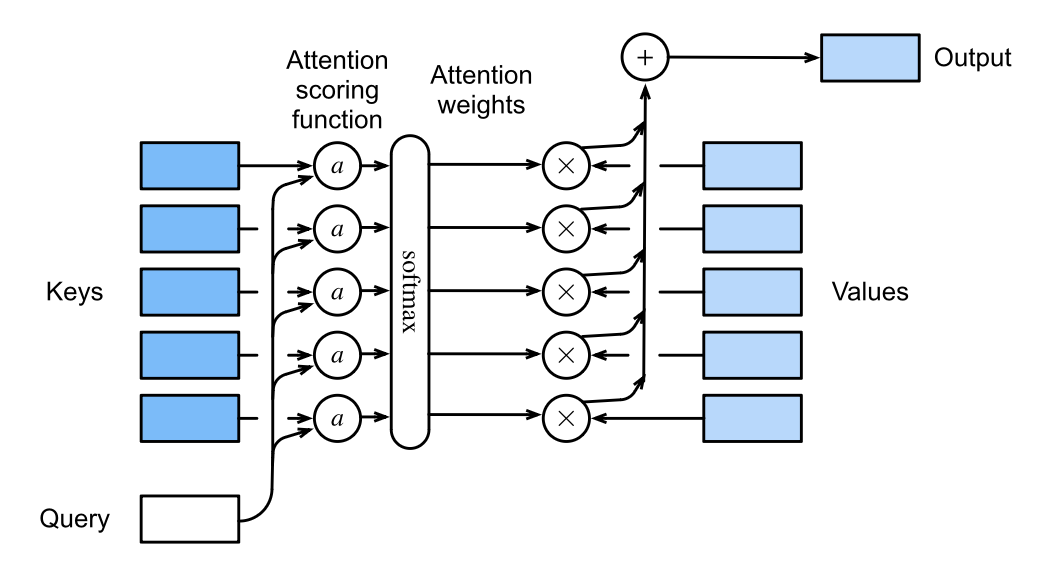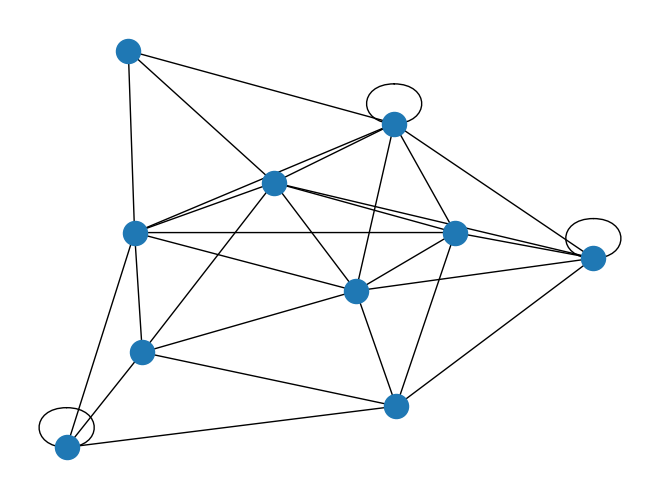Message Passing Transformers
This post shows a graph (“message passing” or “soft dictionary lookup”) interpretation of Attention. It combines two really great references on the topic that show that forward passes through transformers are similar to message passing algorithms for probabilistic graphical models. But instead of the NP-hardness of the Belief Propagation algorithm, transformers scale as $O(n^2 * d)$ with the data.
Attention as soft dictionary lookup
This was inspired from Section 15.4.1 of Kevin Murphy’s Probabilistic Machine Learning (PML) textbook. Attention operation accepts a query (from a node) and a set of (key, value) tuples (from all other nodes):
The attention weights $\alpha_i$:
\[\alpha_i(\pmb q, \pmb k_{1:m}) = \text{softmax}_i([a(\pmb q, \pmb k_1), \dots, a(\pmb q, \pmb k_m)]) = \frac{\exp{a(\pmb q, \pmb k_i)}}{\sum_{j=1}^m \exp{a(\pmb q, \pmb k_j)}}\]have the properties:
\[0 \leq \alpha_i(\pmb q, \pmb k_{1:m}) \leq 1\] \[\sum_i \alpha_i(\pmb q, \pmb k_{1:m}) = 1\]For attention score $a$ which computes the similarity between $\pmb q$ and $\pmb k_i$:
\[a: \pmb q \times \pmb k_i \rightarrow \mathbb R\]Finally, the computation graph can be visualized as (credit to Dive into Deep Learning): 
Message Passing (Python)
This python code directly taken from Andrej Karpathy’s lecture on Transformers. The idea is to represent each data point (embeddings of tokens in a sequence) as a node in a graph and then connect them (fully or casually). Instead of dealing with this data directly, we project the data into the query, key, and value data. This improves the representation of the underlying data. The algorithm finally updates itself by taking a convex combination of the values with attention scores (i.e. the attention weights).
1
2
3
import numpy as np
import networkx as nx
from pprint import pprint
Implementation
1
2
3
4
5
6
7
8
9
10
11
12
13
14
15
16
17
18
class Node:
def __init__(self):
self.data = np.random.randn(20)
self.wkey = np.random.randn(20, 20)
self.wquery = np.random.randn(20, 20)
self.wvalue = np.random.randn(20, 20)
def key(self):
# what do I have
return self.wkey @ self.data
def query(self):
# what am I looking for?
return self.wquery @ self.data
def value(self):
# what do I publicly reveal/broadcast to others?
return self.wvalue @ self.data
1
2
3
4
5
6
7
8
9
10
11
12
13
14
15
16
17
18
19
20
21
22
23
24
25
26
27
28
29
30
31
32
33
34
35
36
37
38
39
40
41
42
43
class Graph:
def __init__(self):
self.nodes = [Node() for i in range(10)]
randi = lambda: np.random.randint(len(self.nodes))
self.edges = [(randi(), randi()) for _ in range(40)]
# dedup edges
self.edges = list(set(list(self.edges)))
def run_node(self, i: int, n: Node) -> np.ndarray:
print(f"++++ ito: {i}")
# each node has one question
q = n.query()
ifroms = [ifrom for (ifrom, ito) in self.edges if ito == i]
inputs = [self.nodes[ifrom] for ifrom in ifroms]
print(f"\tifroms: {ifroms}")
# each key from all connected nodes
keys = [m.key() for m in inputs]
scores = [k.dot(q) for k in keys]
print(f"\tscores: {scores}")
scores = np.exp(scores)
scores = scores / np.sum(scores)
print(f"\tAttention weights: {scores}")
print(f"\tsum_i scores_i = {sum(scores)}")
# each value from all connected nodes
values = [m.value() for m in inputs]
# each vector is (20,)
updates = [s * v for s, v in zip(scores, values, strict=True)]
# resulting update is (20,)
update = np.array(updates).sum(axis=0)
print()
return update
def run(self):
updates = []
for i, n in enumerate(self.nodes):
update = self.run_node(i=i, n=n)
updates.append(update)
# add all
for n, u in zip(self.nodes, updates, strict=True):
n.data = n.data + u
Results
1
2
3
4
5
6
7
8
9
graph = Graph()
G = nx.from_edgelist(graph.edges)
print(G)
print()
print("Nodes")
print(G.nodes)
print()
print("Edge List")
pprint({k: list(dict(v).keys()) for k, v in G.adj.items()})
1
2
3
4
5
6
7
8
9
10
11
12
13
14
15
16
Graph with 10 nodes and 30 edges
Nodes
[4, 0, 3, 9, 7, 6, 5, 8, 1, 2]
Edge List
{0: [4, 8, 3, 7, 6],
1: [6, 9, 2, 5, 8, 1, 4],
2: [5, 8, 4, 1, 6, 7],
3: [4, 7, 0, 3],
4: [0, 3, 9, 6, 2, 8, 1],
5: [7, 2, 6, 8, 1, 5],
6: [4, 8, 1, 5, 0, 2, 9],
7: [3, 5, 0, 8, 2],
8: [6, 0, 2, 4, 5, 1, 7],
9: [4, 1, 6]}
1
nx.draw(G)
1
graph.run()
1
2
3
4
5
6
7
8
9
10
11
12
13
14
15
16
17
18
19
20
21
22
23
24
25
26
27
28
29
30
31
32
33
34
35
36
37
38
39
40
41
42
43
44
45
46
47
48
49
50
51
52
53
54
55
56
57
58
59
60
61
++++ ito: 0
ifroms: [4, 3, 7, 6]
scores: [66.28713441407328, -42.356895194685464, -72.42356412336589, 37.33998459065121]
Attention weights: [1.00000000e+00 6.55386436e-48 5.73731961e-61 2.68171465e-13]
sum_i scores_i = 0.9999999999999999
++++ ito: 1
ifroms: [9, 1]
scores: [211.47668629424436, 77.85702511746038]
Attention weights: [1.00000000e+00 9.32649533e-59]
sum_i scores_i = 1.0
++++ ito: 2
ifroms: [4, 1, 7]
scores: [35.58941250531445, -53.70434487821338, -80.78903024029921]
Attention weights: [1.00000000e+00 1.66040449e-39 2.86737506e-51]
sum_i scores_i = 1.0
++++ ito: 3
ifroms: [4, 3, 7]
scores: [31.240260256884994, 5.379888043038299, 59.36660338598627]
Attention weights: [6.09374649e-13 3.57987144e-24 1.00000000e+00]
sum_i scores_i = 1.0
++++ ito: 4
ifroms: [0, 8, 1]
scores: [-23.23660787608064, 34.19954420654749, -74.67617928930356]
Attention weights: [1.13709327e-25 1.00000000e+00 5.19845241e-48]
sum_i scores_i = 1.0
++++ ito: 5
ifroms: [2, 8, 1, 5]
scores: [-79.00370928667077, 19.908000741887548, -75.48698208523935, -44.17319414548691]
Attention weights: [1.10456210e-43 1.00000000e+00 3.71950680e-42 1.47873607e-28]
sum_i scores_i = 1.0
++++ ito: 6
ifroms: [4, 8, 1, 5, 0, 2]
scores: [-23.987304007919384, 8.42476207930093, -84.15587488072015, 69.30330615398142, -287.98108781017044, -11.46404257694845]
Attention weights: [3.05072312e-041 3.63734288e-027 2.25696321e-067 1.00000000e+000
6.81332697e-156 8.37888304e-036]
sum_i scores_i = 1.0
++++ ito: 7
ifroms: [3, 5, 8]
scores: [-23.8989411122908, -6.459026663244714, 13.084969606201714]
Attention weights: [8.67144860e-17 3.25199796e-09 9.99999997e-01]
sum_i scores_i = 1.0
++++ ito: 8
ifroms: [0, 2, 6, 4, 1, 7]
scores: [-44.044223084610195, 18.67462267889491, 71.68866337449023, -32.61671246043159, -52.38386938730109, -27.39714905660486]
Attention weights: [5.46822072e-51 9.46879387e-24 1.00000000e+00 5.02054475e-46
1.30612176e-54 9.28065068e-44]
sum_i scores_i = 1.0
++++ ito: 9
ifroms: [4, 6]
scores: [126.73498602992018, -36.7403289419144]
Attention weights: [1.00000000e+00 1.00826056e-71]
sum_i scores_i = 1.0
Summary
From the Attention as a soft dictionary lookup formalism, we can see that Attention’s forward pass is similar to a message passing algorithm. During each step of training, attention tunes the $Q$, $K$, & $V$ projection matrices to achieve more coherent predictions similar to clique calibration in graphical models. In contrast, attention weights do not define joint probability distributions among random variables (like a graphical model), but only distributions over which values should be weighted higher during the forward pass. So while marginal inference is not possible on a trained network with Attention mechanisms, correlations should be preserved from the original nodes.

